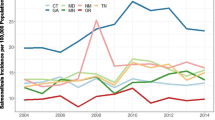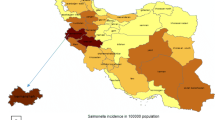Abstract
This is the first study to identify appropriate regression models for the association between climate variation and salmonellosis transmission. A comparison between different regression models was conducted using surveillance data in Adelaide, South Australia. By using notified salmonellosis cases and climatic variables from the Adelaide metropolitan area over the period 1990–2003, four regression methods were examined: standard Poisson regression, autoregressive adjusted Poisson regression, multiple linear regression, and a seasonal autoregressive integrated moving average (SARIMA) model. Notified salmonellosis cases in 2004 were used to test the forecasting ability of the four models. Parameter estimation, goodness-of-fit and forecasting ability of the four regression models were compared. Temperatures occurring 2 weeks prior to cases were positively associated with cases of salmonellosis. Rainfall was also inversely related to the number of cases. The comparison of the goodness-of-fit and forecasting ability suggest that the SARIMA model is better than the other three regression models. Temperature and rainfall may be used as climatic predictors of salmonellosis cases in regions with climatic characteristics similar to those of Adelaide. The SARIMA model could, thus, be adopted to quantify the relationship between climate variations and salmonellosis transmission.


Similar content being viewed by others
References
Adak G, Long SM, O’Brien S (2002) Trends in indigenous foodborne disease and deaths, England and Wales, 1992–2000. Gut 51:832–841
Altizer S, Dobson A, Hosseini P, Hudson P, Pascual M, Rohani P (2006) Seasonality and the dynamics of infectious diseases. Ecol Lett 9:467–484
Bentham G, Langford IH (1995) Climate change and the incidence of food poisoning in England and Wales. Int J Biometeorol 39:81–86
Bentham G, Langford IH (2001) Environmental temperatures and the incidence of food poisoning in England and Wales. Int J Biometeorol 45:22–26
Bi P, Tong S, Donald K, Parton KA, Ni J (2003) Climatic variables and transmission of malaria: a 12-year data analysis in Shuchen County, China. Public Health Rep 118:65–69
Box GEP, Jenkins GM (1976) Time series analysis: forecasting and control. Holden-Day, San Francisco
Brockwell PJ, Davis RA (1991) Time series: theory and methods. Springer, Berlin Heidelberg New York
CDC (2004) Salmonellosis. http://www.cdc.gov/ncidod/dbmd/diseaseinfo/salmonellosis_t.htm. Accessed 2 April 2004
Checkley W, Epstein L, Gilman R, Figueroa D, Cama R, Patz J, Black R (2000) Effect of El Nino and ambient temperature on hospital admissions for diarrhoeal diseases in Peruvian children. Lancet 355:442–450
Curriero F, Patz J, Rose J, Lele S (2001) The association between extreme precipitation and waterborne disease outbreaks in the United States, 1948–1994. Am J Public Heal 91:1194–1199
D’Souza R, Becker N, Hall G, Moodie K (2004) Does ambient temperature affect foodborne disease? Epidemiology 15:86–92
Hall G, Kirk DM, Becker N, Gregory J, Unicomb L, Millard G, Stafford R, Lalor K, the OzFoodNet Working Group (2005) Estimating foodborne gastroenteritis. Emerg Infect Dis 11:1257–1264
Kovats R, Edwards S, Hajat S, Armstrong B, Ebi K, Menne B (2004) The effect of temperature on food poisoning: a time-series analysis of salmonellosis in ten European countries. Epidemiol Infect 132:443–453
Louis V, Gillespie I, O’Brien S, Russek-Cohen E, Pearson A, Colwell R (2005) Temperature-driven Campylobacter seasonality in England and Wales. Appl Environ Microbiol 71:85–92
Martinez-Urtaza J, Saco M, de Novoa J, Perez-Pineiro P, Peiteado J, Lozano-Leon A, Garcia-Martin O (2004) Influence of environmental factors and human activity on the presence of Salmonella serovars in a marine environment. Appl Environ Microbiol 70:2089–2097
Nath G, Singh S, Sanyal S (1992) Childhood diarrhoea due to rotavirus in a community. Indian J Med Res 95:259–262
OzFoodNet (2002) The OzFoodNet working group. http://www.ozfoodnet.org.au
Pinfold J, Horan N, Mara D (1991) Seasonal effects on the reported incidence of acute diarrhoeal disease in northeast Thailand. Int J Epidemiol 20:777–786
Shumway RH, Stoffer DS (2000) Time series analysis and its applications. Springer, Berlin Heidelberg New York
Singh R, Hales S, Wet N, Raj R, Hearnden M, Weinstein P (2001) The influence of climate variation and change on diarrheal disease in the Pacific Islands. Environ Health Perspect 109:55–59
South Australian Department of Health (1991) Communicable diseases control branch: csmart computing program. South Australian Department of Health, Adelaide
SPSS for Windows (2002) Rel. 11.5.1. 2002. SPSS, Chicago
StataCorp (2003) Stata statistical software: release 8. College station, TX
Tam CC, Rodrigues LC, O’Brien SJ, Hajat S (2006) Temperature dependence of reported Campylobacter infection in England, 1989–1999. Epidemiol Infect 134:119–125
Tobias A, Saez M (2004) Time-series regression models to study the short-term effects of environmental factors on health. In: http://www.udg.es/fcee/economia/n11.pdf. Accessed 2 April 2004
Tong S, Bi P, Donald K, McMichael AJ (2002) Climate variability and Ross River virus transmission. J Epidemiol Commun Health 56:617–621
Weisstein EW (2004) Poisson distribution. In: Wolfram A (ed) Mathworld. Web Resource. http://mathworld.wolfram.com/PoissonDistribution.html
WHO (2005) Drug-resistant Salmonella. http://www.who.int/mediacentre/factsheets/fs139/en/ Accessed 2 April 2005
Acknowledgements
We greatly appreciate Dr Andrew Metcalfe, Senior Lecturer in Statistics at the University of Adelaide, for his kind assistance with statistical issues in this study.
Author information
Authors and Affiliations
Corresponding author
Appendix
Appendix
-
1.
Standard poisson regression.
In the standard Poisson regression analysis, the dependent variable is weekly salmonellosis cases. The Poisson distribution has only one parameter, ν, which equals the mean (or variance). The distribution is given by the formula (Weisstein 2004):
$$ {\text{Pr}}{\left( {\text{Y}} \right)} = \frac{{\nu ^{n} e^{{ - \nu }} }} {{n!}} $$The estimation of the parameters is obtained by a maximum likelihood function. The model can be summarized as: ln (ν t) = α + β 1 temperaturet + β 2 rainfallt + sin(2πt/52) + cos(2πt/52)
-
2.
Autoregressive adjusted poisson regression.
According to our previous analysis, there is autocorrelation between both dependent and independent variables. Therefore, the Poisson regression model adjusted for autocorrelation can be given as:
$$ \begin{aligned} & {\text{ln }}{\left( {\nu _{{\text{t}}} } \right)} = \alpha + \beta _{1} {\text{ Y}}_{{{\text{t}} - {\text{1}}}} + \beta _{2} \,{\text{Y}}_{{{\text{t}} - {\text{2}}}} + \,\,\beta _{3} {\text{ Y}}_{{{\text{t}} - {\text{3}}}} + {\text{ }}\beta _{4} {\text{ Y}}_{{{\text{t}} - {\text{4}}}} \\ & + \beta _{5} {\text{temperature}}_{{\text{t}}} + {\text{ }}\beta _{6} {\text{temperaruep}}_{{{\text{t}} - {\text{1}}}} \\ & + {\text{ }}\beta _{7} {\text{temperaturep}}_{{{\text{t}} - {\text{2}}}} {\text{ }} + {\text{ }}\beta _{8} {\text{rainfall}}_{{\text{t}}} + \beta _{9} {\text{rainfall}}_{{{\text{t}} - {\text{1}}}} \\ & + \beta _{{10}} {\text{rainfall}}_{{{\text{t}} - {\text{2}}}} {\text{ }} + {\text{sin}}{\left( {{{\text{2}}\pi {\text{t}}} \mathord{\left/ {\vphantom {{{\text{2}}\pi {\text{t}}} {52}}} \right. \kern-\nulldelimiterspace} {52}} \right)}\, + {\text{cos}}{\left( {{{\text{2}}\pi {\text{t}}} \mathord{\left/ {\vphantom {{{\text{2}}\pi {\text{t}}} {52}}} \right. \kern-\nulldelimiterspace} {52}} \right)} \\ \end{aligned} $$ -
3.
Multiple linear regression.
The regression model is:
$$ \begin{aligned} & {\sqrt {Yt} } = {\text{ }}\alpha + \beta _{1} {\sqrt {Y_{{t - 1}} } } + \beta _{2} {\sqrt {Y_{{t - 2}} } } + \beta _{3} {\sqrt {Y_{{t - 3}} } } + \beta _{4} {\sqrt {Y_{{t - 4}} } } \\ & + \beta _{5} {\text{temperature}}_{{\text{t}}} + \beta _{6} {\text{temperaute}}_{{{\text{t}} - {\text{1}}}} \\ & + \beta _{7} {\text{temperature}}_{{{\text{t}} - {\text{2}}}} + \beta _{8} {\text{rainfall}}_{{\text{t}}} + \beta _{9} {\text{rainfall}}_{{{\text{t}} - {\text{1}}}} \\ & + \beta _{{10}} {\text{rainfall}}_{{{\text{t}} - {\text{2}}}} {\text{ }} + {\text{sin}}{\left( {{{\text{2}}\pi {\text{t}}} \mathord{\left/ {\vphantom {{{\text{2}}\pi {\text{t}}} {52}}} \right. \kern-\nulldelimiterspace} {52}} \right)}\, + {\text{cos}}{\left( {{{\text{2}}\pi {\text{t}}} \mathord{\left/ {\vphantom {{{\text{2}}\pi {\text{t}}} {52}}} \right. \kern-\nulldelimiterspace} {52}} \right)} + Et \\ \end{aligned} $$Where Et is independent random error with mean 0.
-
4.
Seasonal autoregressive moving average (SARIMA) models.
An autoregression moving average (ARMA) model predicts the outcome variable from the values of the outcome at previous time points. It is an approach to handle time-series modelling and forecasting based on the landmark work of Box and Jenkins (1976). The theory and application of the models have been described in many papers and books (Shumway and Stoffer 2000; Brockwell and Davis 1991; Tobias and Saez 2004). The ARMA model is suitable only for stationary processes. The SARIMA model allows for a trend and seasonal effects by differencing. The model described here SARIMA(4,0,0)*(1,0,0)52, which stands for 4-order autoregression and 1-order seasonal autoregression with a period of 52 weeks, has the following form. Let Xt be the square root of Yt. Define Wt by Wt = Xt−Xt−52. Then
$$ \begin{aligned} & Wt = \alpha _{0} + \alpha _{1} {\text{ }}W_{{{\text{t}} - {\text{1}}}} + \alpha _{2} \,W_{{{\text{t}} - {\text{2}}}} + \alpha _{3} \,W_{{{\text{t}} - {\text{3}}}} \, + \alpha _{4} \,W_{{{\text{t}} - {\text{4}}}} \\ & + \beta {\rm E}_{{{\text{t}} - 52}} + \gamma _{1} {\text{Temperature}}_{{\text{t}}} + {\text{ }}\gamma _{2} {\text{Temperaute}}_{{{\text{t}} - {\text{1}}}} \\ & + {\text{ }}\gamma _{3} {\text{Temperature}}_{{{\text{t}} - {\text{2}}}} {\text{ }} + {\text{ }}\gamma _{4} {\text{rainfall}}_{{\text{t}}} + \gamma _{5} {\text{rainfall}}_{{{\text{t}} - {\text{1}}}} \\ & + \gamma _{6} {\text{rainfall}}_{{{\text{t}} - {\text{2}}}} {\text{ }}E_{{\text{t}}} \\ \end{aligned} $$Where Et is independent random error with mean 0.
The Aikake information criterion (AIC) is used to compare models fit to one same series. The model with the smaller AIC fits the data better. AIC = −2 ln(L) + 2 k , where L is the likelihood function and k is the number of free parameters.
Rights and permissions
About this article
Cite this article
Zhang, Y., Bi, P. & Hiller, J. Climate variations and salmonellosis transmission in Adelaide, South Australia: a comparison between regression models. Int J Biometeorol 52, 179–187 (2008). https://doi.org/10.1007/s00484-007-0109-4
Received:
Revised:
Accepted:
Published:
Issue Date:
DOI: https://doi.org/10.1007/s00484-007-0109-4




